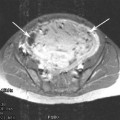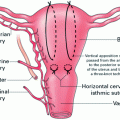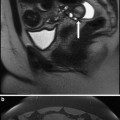Short term
Bleeding
Post-operative pyrexia
Wound infection
Haematoma
Thromboembolism
Paralytic ileus
Injury to adjacent structures (e.g. bowel, bladder)
Hysterectomy
Long term
Intraperitoneal adhesions
Small bowel obstruction
Incisional hernia
Nerve entrapment
Chronic abdominal pain
2.1.1 Short-Term Complications
The most important complication is intra- and post-operative bleeding which may result in hypovolaemia necessitating blood transfusion in 20 % of cases, and in extreme cases, even hysterectomy. Based on some published series, the risk of haemorrhage is in the range of 2–8 % and varies with the size and number of fibroids as well as the intra-operative technique (Roth et al. 2003; West et al. 2006). One of the reasons for this is that although fibroids appear white and relatively avascular, they are surrounded by a plexus of often enlarged vessels in the adjacent myometrium. It is from these vessels that significant blood loss can occur during surgery and a number of techniques, including tourniquets and clamps, have been developed to occlude the uterine and ovarian arteries and minimize blood loss (Taylor et al. 2005). The risk of hysterectomy during myomectomy because of uncontrollable bleeding is, however, low (4 %) (Olufowobi et al. 2004), although higher at repeat myomectomy.
Peri-operative pyrexia is common and may occur in 10–30 % of cases, whilst wound infection may affect 2–5 % of women (Iverson et al. 1996). Myomectomy itself seems to be an independent predicting factor for the development of post-operative pyrexia in the first 48 h post procedure, as was demonstrated in the study by Iverson et al., who compared 101 women who had myomectomy with 160 who had undergone hysterectomy (Iverson et al. 1999). It is likely that the development of haematomas or the presence of necrotic tissue may contribute to the development of pyrexia rather than true infection. Therefore, meticulous haemostasis and the use of post-operative antibiotics may reduce this complication.
Other complications of abdominal myomectomy include those associated with laparotomy. These include thromboembolism, paralytic ileus, atelectasis, nerve damage especially when extending the incision more laterally, urinary tract complications or bowel injury (Mukhopadhaya et al. 2008). However, the risk of visceral injury is low when compared to hysterectomy (Iverson et al. 1996).
2.1.2 Long-Term Complications
Long-term complications after major abdominal surgery such as open myomectomy, include the development of adhesions, incisional hernia and nerve entrapment.
The aetiology of abdominal adhesions is elusive but factors associated with their development post surgery include trauma, thermal injury, infection, presence of blood in the peritoneal cavity, ischaemia or tight suturing resulting in ischaemia (Liakakos et al. 2001; Duron 2007).
In case of open myomectomy, the type of uterine incision seems to have an effect on the development of adhesions. In an early study by Tulandi et al., the authors studied the incidence of adnexal adhesions within 6 weeks after myomectomy. Among women who had a posterior uterine incision 93.7 % (15 out of 16) had adnexal adhesions compared to 55.5 % (5 out of 9) who had an anterior or fundal uterine incision (Tulandi et al. 1993).
Abdominal adhesions are considered to be associated with a range of complaints including infertility, small bowel obstruction, difficult repeat operations, increased risk for ectopic pregnancy or chronic abdominal pain (van der Wal et al. 2011; Swank et al. 2002).
Different pharmacological agents have been tried in order to prevent adhesion formation; however, a recent Cochrane systematic review showed that there is insufficient evidence for the use of steroids, icodextrin 4 %, SprayGel or dextran in reducing adhesion formation. Limited benefit was observed with hyaluronic acid but results were also inconclusive (Metwally et al. 2006). The risk of incisional hernia is about 10 % in patients undergoing major abdominal surgery and a risk factor for herniation is an incision more than 18 cm in length (Savage and Lamont 2000). In general Pfannenstiel incisions have a particularly low incidence of wound dehiscence and incisional herniation. With regard to the risk of nerve entrapment, it increases significantly when the incision extends laterally beyond the later edge of the rectus sheath. Nerve entrapment can result from transaction of the iliohypogastric and ileoinguinal nerves followed by formation of a neuroma, incorporation of the nerve by a suture in the closure of the fascial layers, or tethering or construction of the nerve in the scar tissue. It is important to recognise that symptoms may start early or manifest even years after surgery (Luijendijk et al. 1997).
2.2 Laparoscopic Myomectomy
Laparoscopic myomectomy is a less invasive alternative to laparotomy in cases of relatively small intramural or subserosal fibroids, when the number of fibroids is less than 3 and their size less than 8 cm (Dubuisson 2000). This procedure has also short- and long-term complications (Table 2).
Table 2
Complications of laparoscopic myomectomy
Short term | |
Bleeding Injury to adjacent structures (e.g. bowel, bladder) Specific risks associated with laparoscopy Need to convert to laparotomy Haematoma Hysterectomy | |
Long term | |
Recurrence of fibroids | |
Need for repeat procedure | |
Adhesions Uterine rupture in pregnancy | |
2.2.1 Short-Term Complications
Short-term complications result reported by small randomized controlled trials show that laparoscopic myomectomy may be associated with reduced incidence of pyrexia, fewer blood transfusions and less post-operative pain than open myomectomy (Seracchioli et al. 2000). In addition there seem to be benefits in terms of faster post-operative recovery and reduced hospital stay (Mais et al. 1996).
Although laparoscopic myomectomy is generally done in patients with relatively small and/or few fibroids, intra-operative bleeding remains a major concern. One of the main reasons is because the repair of the uterine incision and the control of bleeding requires expert laparoscopic suturing skills. Mais et al. showed that blood loss was less at laparoscopic compared to abdominal myomectomy (200 ± 50 vs 230 ± 44 ml), but bleeding can be significant (Mais et al. 1996). In the more recent study by Landi et al., 14 of 368 women undergoing laparoscopic myomectomy had significant blood loss and required blood transfusion peri- or postoperatively (Landi et al. 2001).
Another significant complication is the risk for bowel injury which could require laparoscopic or even open repair, or worse, is not recognised at the time but only after the development of peritonitis. All patients undergoing laparoscopy are routinely warned that the procedure may have to be converted to laparotomy in case of bleeding or visceral injury.
2.2.2 Long-Term Complications
There are several studies suggesting that the risk of post-operative adhesions is reduced in cases of laparoscopic compared to abdominal myomectomy. It is estimated that after laparoscopic myomectomy 30.5 % of patients develop adnexal adhesions compared to 68.9 % of patients with abdominal myomectomy (Dubuisson 2000). This difference may be explained by differences in the size and number of fibroids, however, it is also possible that the laparoscopic route itself, the use of fine instruments, atraumatic manipulation and thorough washing may well contribute to this reduction. The clinical symptoms of the developing adhesions would be the same as in abdominal myomectomy.
Fibroid recurrence rate after laparoscopic myomectomy is in the range of 4–30 % with up to 10 % needs to have a repeat surgery (Buttram and Reiter 1981; Rossetti et al. 2001). In a randomised control trial by Rossetti et al., where patients were assigned to either abdominal or laparoscopic myomectomy, there was no significant difference in the recurrence of fibroids within 24 months from the procedure (23 vs 27 % respectively) (Rossetti et al. 2001). However, other studies state that the risk of recurrence is higher in laparoscopic than abdominal myomectomy (Seracchioli et al. 2000). One specific problem of the laparoscopic technique is that the loss of tactile sensation makes it impossible to palpate the myometrium thoroughly and as a result, small intramural fibroids that do not deform the uterine serosa are easily missed and not excised. The pre-operative use of GnRH analogues is a controversial topic; some patients undergoing myomectomy may be treated with GnRH analogues with the aim to reduce the volume of fibroids and the vascularisation of the uterus. A randomised controlled trial by Fedele et al., looking at women who have been or not pre-treated with a GnRH analogue, showed that there was no difference in the duration of operation or intra-operative blood loss between the two groups. However, women who had been pre-treated with a GnRH analogue had a higher risk for recurrence of fibroids in the short term when they have been examined by transvaginal ultrasound within 6 months. These fibroids were intramural and less than 1.5 cm in diameter, which would have been difficult to identify with an abdominal ultrasound alone. The increased frequency of recurrence in these patients may be due to the fact that the GnRH analogue may induce a decrease in the volume and consistence of the fibroid making the smaller fibroids unidentifiable during the operation (Fedele et al. 1990). In a more recent study Rossetti et al., reported on 84 women who underwent laparoscopic myomectomy and were followed up for 36 months. In this study the only significant risk factor for recurrence of fibroids was the pre-operative use of a GnRH analogue. The authors also hypothesised that in these cases smaller intramural fibroids would have been difficult to visualise and, therefore, overlooked leaving fibroids in situ and so leading to higher recurrence rate (Rossetti et al. 2001).
2.3 Vaginal Myomectomy
As discussed in the previous chapter, the term ‘vaginal myomectomy’ encompasses four different technique types that can be used to remove fibroids depending on the position, size and number of fibroids to be removed, even in nulliparous women (Magos et al. 1994). Irrespective of the type of vaginal myomectomy, this route of surgery offers the possibility to remove greater fibroid mass with less operative time and postoperative pain, and better surgical repair of the uterus than, for instance, laparoscopic myomectomy (Thomas and Magos 2011). Depending on the experience of the surgeon, the procedure is also easier to perform compared to laparoscopic myomectomy while retaining the advantages of minimally invasive therapy. Nonetheless, it still represents potentially relatively major surgery and is not without short- and long-term risks.
2.3.1 Short-Term Complications
Vaginal myomectomy is associated with significantly lower incidence of postoperative pyrexia and shorter hospital stay compared with open surgery (Ben-Baruch et al. 1988; Plotti et al. 2008). The main complication is the risk of failure to complete the procedure vaginally and the need to convert to laparotomy. The rate of conversion to laparotomy is in the range of 8–9 % (Agostini et al. 2004; Birsan et al. 2003), but very much depends on patient selection. In the recent study by Agostini et al., 108 women had vaginal myomectomy by posterior colpotomy, 27 women had complications (25 %) including 17 (15.7 %) who were converted to laparotomy in order to complete the myomectomy. Complications included rectal injury (0.9 %) necessitating laparotomy, haemorrhage with Hb less than 6 g/dL (2.8 %), haematoma which drained spontaneously (0.9 %) and five cases of abscesses (4.7 %) treated conservatively or with vaginal surgical evacuation in two cases (Agostini et al. 2008).
2.3.2 Long-Term Complications
Studies regarding the long-term complications after vaginal myomectomy are still rare (Faivre et al. 2010). Post-operative development of adhesions may be a risk, although its incidence is unknown; in another study there no reported adhesions in the pouch of Douglas when patients were examined laparoscopically between 6 and 24 months after the procedure (Davies et al. 1999). The type of the incision used on vaginal hysterotomy may in theory compromise the integrity of the cervix and cause stenosis and cervical weakness in future pregnancies, but there is no evidence that this actually occurs. Uterine rupture during pregnancy or delivery may also be a potential complication, although there are no cases reported in the literature (Faivre et al. 2010; Rovio and Heinonen 2006). It is likely that the uterine repair performed vaginally is considerably stronger than when done by laparoscopic suturing.
2.4 Hysteroscopic Myomectomy
Hysteroscopic myomectomy is the preferred technique for removing submucous fibroids, particularly those that are totally or mostly inside the uterine cavity. Fibroids extending deep into the myometrium can also be excised hysteroscopically although this requires greater surgical skill to avoid uterine perforation. The optimum instrument for removing submucous fibroids remains the resectoscope, and since the advent of the mini-resectoscope, the procedure can be carried out in the outpatient clinic or in office setting with no or minimal need for local anaesthesia (Chapman and Magos 2006). This procedure is not void of complications, that are however uncommon and can be avoidable by good technique (Table 3).
Table 3
Complications of hysteroscopic myomectomy
Short term | |
Uterine perforation Fluid overload Electrolyte abnormalities Haemorrhage Cervical trauma Injury to adjacent structures (e.g. bowel, bladder) Infection Hysterectomy | |
Long term | |
Intrauterine adhesions Secondary amenorrhoea (Asherman’s syndrome) Uterine rupture during pregnancy | |
2.4.1 Short-Term Complications
The reported rate of intra- or peri-operative complications varies widely between 0.3 and 28 % depending on the study. These complications include uterine perforation, which can be associated with damage to adjacent structures such as bowel, bladder and even blood vessels, cervical trauma, bleeding during surgery, infection, gas embolism and fluid overload (Di Spiezio et al. 2008). Uterine perforation may occur at any of these steps of the procedure: cervical dilation, insertion of hysteroscope or resection of fibroids. The risk seems to be higher in cases of deep fibroids within the myometrium (Murakami et al. 2005).
Fluid overload and the associated electrolyte imbalance is a serious complication, particularly if electrolyte-free uterine distension media are used as is necessary with monopolar electrosurgery. Fluid absorption occurs through the rich plexus of the vessels surrounding the fibroid and from transperitoneal absorption via the fallopian tubes. Severe fluids overload can cause hyponatremia, pulmonary oedema, heart failure, cerebral oedema and, in extreme cases, even death. Therefore careful monitoring of fluid balance is required during the procedure and if there is fluid overload, surgery should be stopped, U&Es checked, diuretics given and urine output monitored for diuresis. Deep intramural fibroids represent a higher risk for this complication mainly because of damage to larger size vessels. The size of the fibroid itself and the length of the procedure can also contribute to the risk of this complication (Murakami et al. 2005; Di Spiezio et al. 2008).
A complete resection is almost always achieved for submucous fibroids without intramural extension (type 0) or with those with intramural part of less than 50 % (type I). If the fibroid has an intramural part of 50 % or more (type II), there is the risk of incomplete resection and need for repeat surgery. This risk has been reported between 5 and 20 % depending on the study (Polena et al. 2007; Emanuel et al. 1999).
2.4.2 Long-Term Complications
Late complications of hysteroscopic myomectomy include intrauterine adhesions and uterine rupture during pregnancy, both of which are important problems for patients who want to have children. The incidence of the post-operative intrauterine adhesion has been reported between 1 and 13 % after hysteroscopic myomectomy (Murakami et al. 2005). However, in some studies this rises up to 45 % after resection of multiple fibroids (Taskin et al. 2000). The precise mechanism of the formation of post-myomectomy adhesions is not obvious in many cases; it would seem logical to assume that reducing trauma to healthy endometrium and the judicious use of electrosurgery during myomectomy, especially for deep intramural fibroids, could reduce the risk of this complication (Gambadauro et al. 2012). The association of endometrial trauma and formation of adhesions that may lead to secondary amenorrhoea has been described as Asherman’s syndrome.
After hysteroscopic myomectomy, especially in cases of deep intramural fibroids, there is a risk of uterine rupture in pregnancy or during labour. We must note, however, that this is a rare complication, with only two reported cases to date (Di Spiezio et al. 2008). Although some surgeons believe that caesarean section should be preferred after removal of fibroids with intramural component (Cravello et al. 2004), there is lack of strong evidence to suggest that this would reduce the risk of uterine rupture.
3 Results of Myomectomy
3.1 Results on Fertility
Fibroids may cause reproductive dysfunction, although the relationship between fibroids and infertility is poorly established. Most studies estimate that uterine fibroids account for up to 5–10 % of cases of infertility; however, when all other causes of infertility are excluded fibroids may account for only 2–3 % of cases.
There are a number of isolated studies on the results of myomectomy on fertility, but the lack of large, randomised controlled trials makes it difficult to draw any firm conclusions. There is evidence that submucous fibroids impair fertility and their removal improves reproductive outcome (Connolly et al. 2000; Pritts et al. 2009). Intramural fibroids distorting the uterine cavity may also decrease fertility. But a recent meta-analysis has shown that their removal will not always improve fertility (Pritts et al. 2009). It is clear that subserosal fibroids do not seem to have an impact.
The rate of pregnancy after myomectomy in patients with unexplained infertility depends on the study and route of myomectomy. For abdominal myomectomy it has been reported between 65.3 and 66.7 % conceive after surgery (Ribeiro et al. 1999; Verkauf 1992). For laparoscopic myomectomy the rate of pregnancy ranges between 33 and 48 % (Dubuisson et al. 1996




Stay updated, free articles. Join our Telegram channel

Full access? Get Clinical Tree






